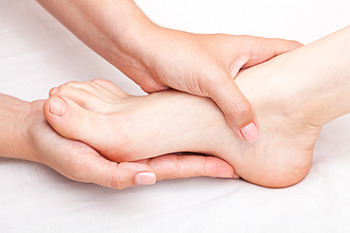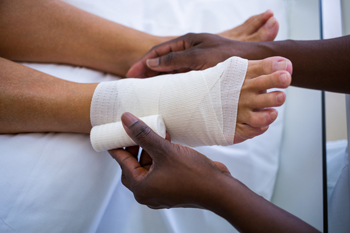1648 US Highway 130
North Brunswick, NJ 08902

There are branches of medicine that target specific areas of the body. Podiatry is aimed at treating disorders of the feet and ankles that can include common ailments, injuries, and deformities. The mandatory education to become a podiatrist begins with earning a bachelor's degree, followed by completing four years at a podiatric school. A residency program that will take three years to complete starts after podiatry school. This generally takes place in a hospital setting, which can provide the students with practical experience. At this point, qualified candidates will become a Doctor of Podiatric Medicine, which is abbreviated as DPM, and these letters will follow their name. Podiatry has become a popular branch of medicine as a result of increased incidents of diabetes and chronic diseases. These types of illnesses can affect the feet, and medical attention is often sought for relief. There are various forms of podiatry that can include sports medicine, wound care, and pediatrics. If you are interested in pursuing podiatry as a career, it is suggested that you converse with this type of doctor who can answer any questions you may have.
If you are experiencing pain in the feet or ankles, don’t join the stubborn majority refusing treatment. Feel free to contact Dr. Robert Fink from Brunswick Foot & Ankle Group. Our doctor can provide the care you need to keep you pain-free and on your feet.
What Is a Podiatrist?
Someone would seek the care of a podiatrist if they have suffered a foot injury or have common foot ailments such as heal spurs, bunions, arch problems, deformities, ingrown toenails, corns, foot and ankle problems, etc.
Podiatric Treatment
A podiatrist will treat the problematic areas of the feet, ankle or lower leg by prescribing the following:
A common podiatric procedure a podiatrist will use is a scanner or force plate which will allow the podiatrist to know the designs of orthotics. Patients are then told to follow a series of tasks to complete the treatment. The computer will scan the foot a see which areas show weight distribution and pressure points. The podiatrist will read the analysis and then determine which treatment plans are available.
If you have any questions please feel free to contact our office located in North Brunswick, NJ . We offer the newest diagnostic and treatment technologies for all your foot and ankle needs.

Wound healing occurs when repair is done for skin damage. The first response from the body is known as the hemostasis phase, which happens as the injury occurs. This is the body’s natural response for wound care, as it stops any bleeding or fluids. Wounds can range from superficial to serious, and there are three types of wound care that are applicable, depending on what type of wound it is. Some wounds require staples, stitches or glue, and these are classified as primary wound healing. A large amount of tissue loss may result in having secondary wound healing performed. This is done when the wound is too large to stitch, or if the wound is in a place where stitches would be uncomfortable. Wounds that are infected may require a tertiary wound healing procedure, which is the delayed closure of a wound so proper drainage can take place. If you have a wound on your foot, it is strongly suggested that you speak with a podiatrist as quickly as possible who can determine what the proper type of wound care is for you.
Wound care is an important part in dealing with diabetes. If you have diabetes and a foot wound or would like more information about wound care for diabetics, consult with Dr. Robert Fink from Brunswick Foot & Ankle Group. Our doctor will assess your condition and provide you with quality foot and ankle treatment.
What Is Wound Care?
Wound care is the practice of taking proper care of a wound. This can range from the smallest to the largest of wounds. While everyone can benefit from proper wound care, it is much more important for diabetics. Diabetics often suffer from poor blood circulation which causes wounds to heal much slower than they would in a non-diabetic.
What Is the Importance of Wound Care?
While it may not seem apparent with small ulcers on the foot, for diabetics, any size ulcer can become infected. Diabetics often also suffer from neuropathy, or nerve loss. This means they might not even feel when they have an ulcer on their foot. If the wound becomes severely infected, amputation may be necessary. Therefore, it is of the upmost importance to properly care for any and all foot wounds.
How to Care for Wounds
The best way to care for foot wounds is to prevent them. For diabetics, this means daily inspections of the feet for any signs of abnormalities or ulcers. It is also recommended to see a podiatrist several times a year for a foot inspection. If you do have an ulcer, run the wound under water to clear dirt from the wound; then apply antibiotic ointment to the wound and cover with a bandage. Bandages should be changed daily and keeping pressure off the wound is smart. It is advised to see a podiatrist, who can keep an eye on it.
If you have any questions, please feel free to contact our office located in North Brunswick, NJ . We offer the newest diagnostic and treatment technologies for all your foot care needs.

People who enjoy running learn that they can benefit from wearing the right type of running shoes. Experts have shown there are three categories of running shoes, and it is important to choose the pair that best describes the preferred running style. Shoes that are supportive and controlling are worn to reduce excessive pronation, which is described as the feet rolling inward while running. These types of shoes are constructed with stronger materials on the inside of the heel. This design may help keep the heels stable. Stability and cushioned shoes are less heavy than controlling shoes and are considered to be the most popular type of running shoe. The lightest running shoes are referred to as cushioned and neutral trainers, and people who enjoy fast running may opt to choose this type of shoe. If you would like more information about what type of running shoes to purchase, it is suggested that you speak with a podiatrist who can address any questions you may have.
If you are a runner, wearing the right running shoe is essential. For more information, contact Dr. Robert Fink from Brunswick Foot & Ankle Group. Our doctor can provide the care you need to keep you pain-free and on your feet.
Choosing the Right Running Shoe for Your Foot Type
To increase performance and avoid the risk of injury, it is important to choose the right running shoe based on your foot type. The general design of running shoes revolves around pronation, which is how the ankle rolls from outside to inside when the foot strikes the ground.
If you have any questions please feel free to contact our office located in North Brunswick, NJ . We offer the newest diagnostic and treatment technologies for all your foot and ankle needs.

There are several reasons the top of your foot can hurt, including fractures and bruises. However, chronic foot conditions can also result in pain in this area. It is easy to forget how complex the foot is with its many tendons, muscles, joints, and bones. Health issues and foot injuries can upset the balance of the foot and cause pain and movement problems. The middle of the foot is referred to as the Lisfrank area, or the midfoot. It is made up of small bones that help form the arch of the foot. Pain in this area can be due to dropping something heavy on the foot, falling, or possibly from a ganglion cyst pressing on a muscle or joint in the foot. A hairline fracture in this area of the foot from overuse or prolonged running can cause pain. Treatment ranges from rest to surgery. Due to the preponderance of reasons for this type of foot pain, it is suggested that you visit a podiatrist for a thorough evaluation and treatment based on an actual diagnosis.
Foot Pain
Foot pain can be extremely painful and debilitating. If you have a foot pain, consult with Dr. Robert Fink from Brunswick Foot & Ankle Group. Our doctor will assess your condition and provide you with quality foot and ankle treatment.
Causes
Foot pain is a very broad condition that could be caused by one or more ailments. The most common include:
Diagnosis
To figure out the cause of foot pain, podiatrists utilize several different methods. This can range from simple visual inspections and sensation tests to X-rays and MRI scans. Prior medical history, family medical history, and any recent physical traumatic events will all be taken into consideration for a proper diagnosis.
Treatment
Treatment depends upon the cause of the foot pain. Whether it is resting, staying off the foot, or having surgery; podiatrists have a number of treatment options available for foot pain.
If you have any questions, please feel free to contact our office located in North Brunswick, NJ . We offer the newest diagnostic and treatment technologies for all your foot care needs.